Top speed 404 km/h Length 22 m Retired 1989 | Wingspan 32 m Introduced 12 June 1953 First flight September 10, 1949 | |
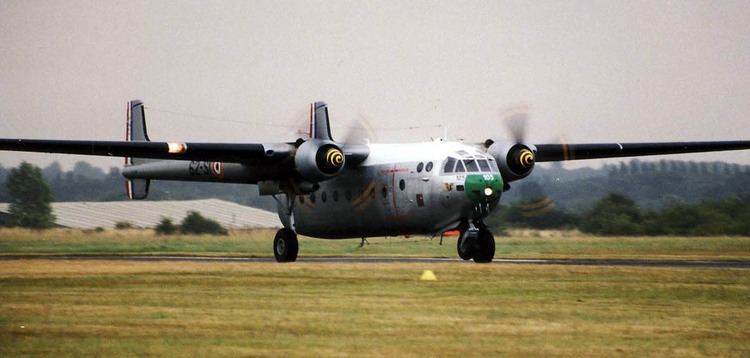 | ||
The Nord Noratlas was a 1950s French military transport aircraft intended to replace the older types in service at the end of World War II. Several hundred were produced in a run lasting over a decade, finding a wide variety of uses.
Contents
- Development
- French Air Force
- German Air Force
- Israel Air Force
- Hellenic Air Force
- Portuguese Air Force
- Other Air Forces
- Civilian
- Variants
- Specifications Nord N 2501
- References
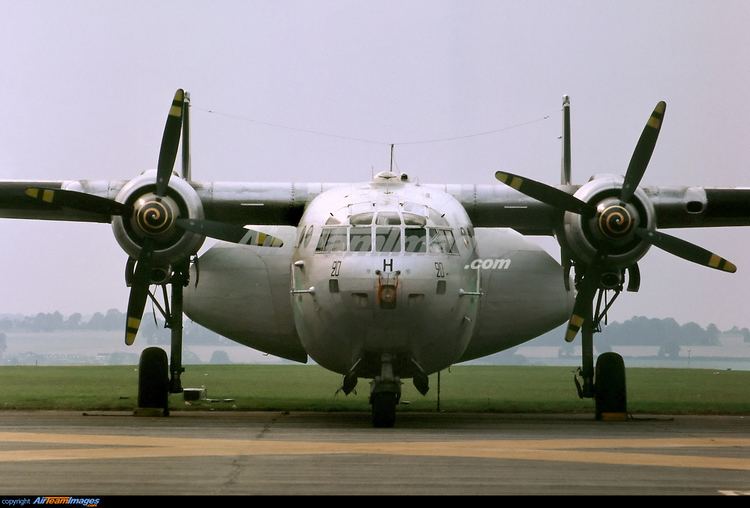
Development
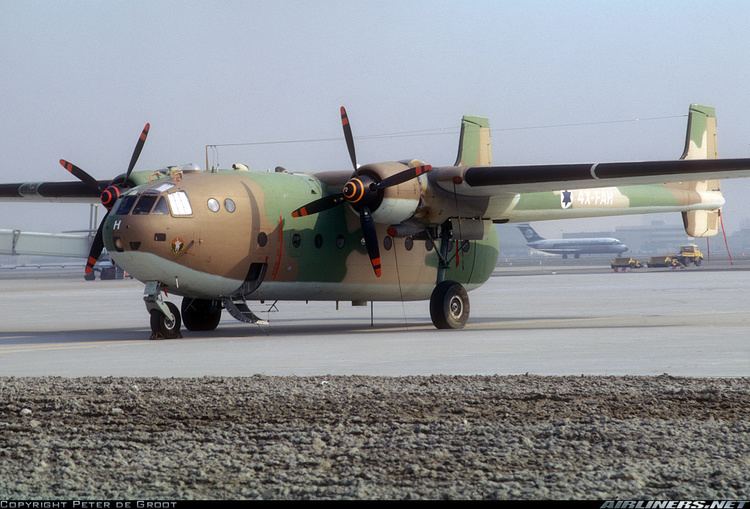
At the end of World War II, the French Armée de l'Air was left with two primary transport aircraft: the Junkers Ju 52, built in France after the end of the war, and the Douglas C-47, received from US surplus. While both had given good service, they were no longer modern, and they suffered from a common set of flaws: a tailwheel landing gear which gave them a nose-up attitude when at rest complicating cargo stowing, restrictive side-loading doors and limited payload.
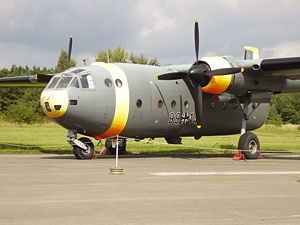
Accordingly, in 1947 Direction Technique Industrielle organized a design competition for a medium-weight cargo aircraft offering great flexibility in use. Société Nationale de Construction Aéronautique du Nord (SNCAN) answered with the Nord 2500, while their competitors, Breguet and SNCASO, offered the BR-891R Mars and SO-30C respectively. The Nord 2500, with its rear-opening clamshell doors allowing ease of loading, was considered the most promising, and DTI ordered two prototypes on April 27, 1948.

The first prototype took to the air on September 10, 1949 powered by two Gnome-Rhône 14R engines of 1,600 hp driving 3-bladed variable-pitch propellers, but it was found to be too slow for most applications. The second prototype replaced the 14Rs with two SNECMA-built Bristol Hercules 738/9 2,040 hp engines driving four-bladed propellers, and this model was rechristened the Nord 2501. DTI ordered 3 more preproduction Nord 2501s, which they flight-tested extensively against the similar Fairchild C-82 Packet. The N-2501 was found superior, and the first 34 were ordered on July 10, 1951.
After an eventual production run of some 425 planes, the last Noratlas was constructed in 1961.
French Air Force
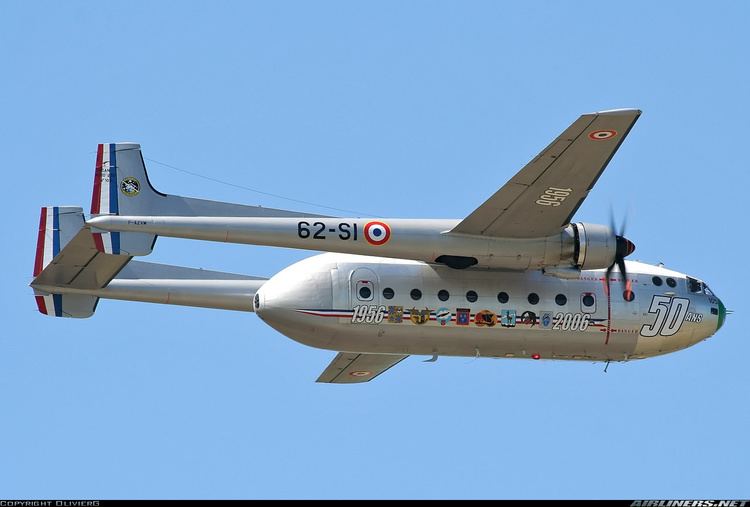
The Noratlas gained fame during the Suez Crisis of 1956, when French paratroopers dropped over the south of Port Said and Port Fouad in Egypt. Its history began four years earlier.

1952 was marked by the unfortunate crash of the first Nord 2501 prototype as it underwent further testing, and on January 9, 1953, the Nord 2501 was baptized the Noratlas by the widow of the pilot killed in the crash. Despite this setback, the program was able to fulfill its initial contract for 34 planes by June 25, 1953, and the Armée de l'Air went on to order another 174 planes, for a total of 208.
These were initially overwhelmingly cargo planes, though 10 were ordered fitted out for passengers; however, following the conclusion of operations in Algeria in 1962, many were converted to other roles (detailed below). Of these modifications, the eight Nord Gabriels (an electronic warfare platform) were useful the longest, and it was the last of this type that was finally phased out in 1989 by the Armée de l'Air.
German Air Force
West Germany, faced with the same situation that had prompted the development of the Noratlas, eventually ordered a total of 186 Noratlases from 1956 on, of which 25 were built in France, and the other 161 manufactured in West Germany by Flugzeugbau Nord under contract, designated N-2501D. Of these aircraft only 173 were delivered. The German Air Force began selling its Noratlases in 1964, and is the source for most of the aircraft for the smaller national operators listed below.
Israel Air Force
The Israeli Air Force (IAF) initially purchased three examples of the N-2501IS in 1956, but under duress—the French government would only allow them to purchase 12 Dassault Ouragans if they purchased three Noratlases as well. The Israelis were upset by the terms of the offer, but France was one of very few countries willing to sell them modern arms, and eventually the Israelis agreed. However, they quickly realized the utility of the Noratlas following its performance in the Suez Crisis, and purchased another three N-2501ISs in 1959, and 16 N-2501Ds before the Six-Day War. These were primarily intended for cargo and paratroop transport, although several were put to more unconventional use as bombers on long-range strikes into Egypt (Operation Drought), much as the contemporary C-130s deployed the Daisy Cutter bomb in Vietnam. It is also known that the IAF used their Noratlases for maritime reconnaissance at the outset of the Six-Day War, and one of these supposedly identified the USS Liberty prior to the strafing of the ship. The IAF phased the Noratlas out in 1978.
Hellenic Air Force
In 1970, the Hellenic Air Force (HAF) received 50 surplus Noratlases from Germany as World War II compensations and NATO help. These Noratlases were based at Elefsis AFB near Athens, with the 354th Tactical Airlift Squadron (112th Tactical Fighter Wing). Hellenic Air Force 354th Sqdr Noratlases were used in the Operation Niki, which airlifted the 1st Greek Rangers Squadron from Crete (Souda) to Cyprus (Nicosia) on the night of July 21–22, 1974, during the Turkish invasion of Cyprus. In spite of the aircraft age and the adverse flying conditions, 12 of the 15 aircraft which participated in operation Niki (Victory in Greek) managed to land at Nicosia International Airport. The Greek 1st Rangers Squadron managed to keep the Nicosia airport in UN hands and did not surrender it to the Turkish Brigade which attacked it.
Portuguese Air Force
The Portuguese Air Force extensively operated the Nord Noratlas in the three African theatres of operations of the Portuguese Colonial War, from 1961 to 1975. The Noratlas were mainly used in the intra-theatre tactical transportation missions and in the launching of paratroopers in airborne assault operations.
In 1960, Portugal purchased six militarized N-2502A (designated N-2502F) from Union Aéromaritime de Transport, (UAT), followed by other six of the same model directly from Nord Aviation. Later, 19 additional N-2501Ds were purchased from the German Air Force.
In the Portuguese Air Force, the Noratlas were operated by the following units:
With the independence of Angola and Mozambique in 1975, six ex-Portuguese Noratlas were given to the governments of these two new countries. Remaining Noratlas aircraft in Portuguese service were retired by September 1977.
Other Air Forces
Used French and German aircraft were bought by Niger (4), Nigeria (6) and Chad (10).
Civilian
The N-2502A/B, which added two small Turbomeca Marboré IIE turbojets at the wingtips, was used primarily by civil operators such as Aéromaritime du Transport (N-2502A) and CGTA-Air Algérie (N-2502B), but never found the success of the military versions, and only ten were built. There were also several variants of limited service that are mentioned below.
Variants
Specifications (Nord N-2501)
Data from Macdonald Aircraft Handbook.
General characteristics
Performance
